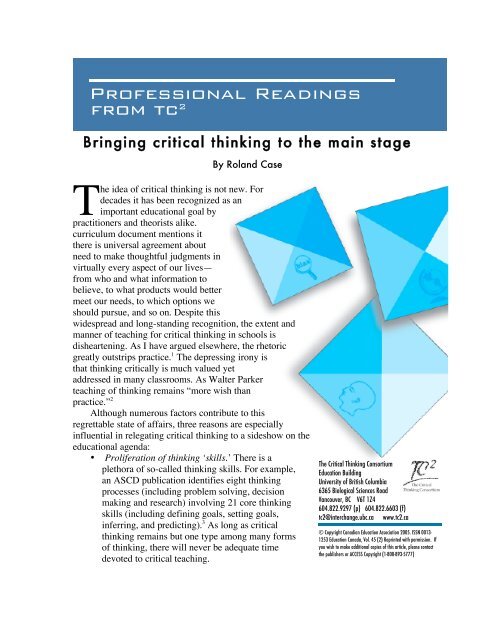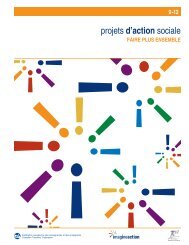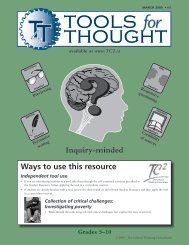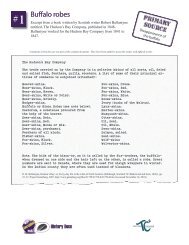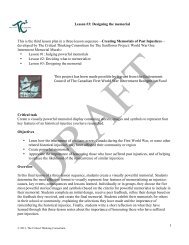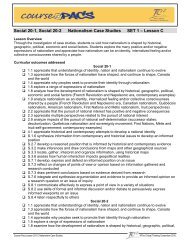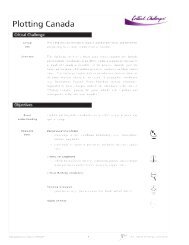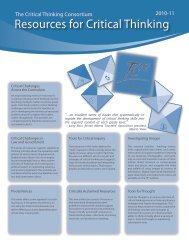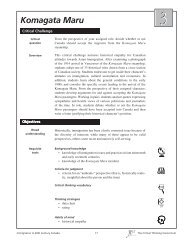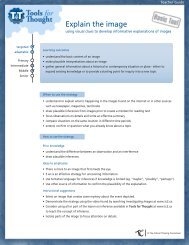Professional Readings from tc2 - The Critical Thinking Consortium
Professional Readings from tc2 - The Critical Thinking Consortium
Professional Readings from tc2 - The Critical Thinking Consortium
You also want an ePaper? Increase the reach of your titles
YUMPU automatically turns print PDFs into web optimized ePapers that Google loves.
<strong>Professional</strong> <strong>Readings</strong><br />
<strong>from</strong> tc 2<br />
Bringing critical thinking to the main stage<br />
By Roland Case<br />
T<br />
he idea of critical thinking is not new. For<br />
decades it has been recognized as an<br />
important educational goal by<br />
practitioners and theorists alike.<br />
curriculum document mentions it<br />
there is universal agreement about<br />
need to make thoughtful judgments in<br />
virtually every aspect of our lives—<br />
<strong>from</strong> who and what information to<br />
believe, to what products would better<br />
meet our needs, to which options we<br />
should pursue, and so on. Despite this<br />
widespread and long-standing recognition, the extent and<br />
manner of teaching for critical thinking in schools is<br />
disheartening. As I have argued elsewhere, the rhetoric<br />
greatly outstrips practice. 1 <strong>The</strong> depressing irony is<br />
that thinking critically is much valued yet<br />
addressed in many classrooms. As Walter Parker<br />
teaching of thinking remains “more wish than<br />
practice.” 2<br />
Although numerous factors contribute to this<br />
regrettable state of affairs, three reasons are especially<br />
influential in relegating critical thinking to a sideshow on the<br />
educational agenda:<br />
• Proliferation of thinking ‘skills.’ <strong>The</strong>re is a<br />
plethora of so-called thinking skills. For example,<br />
an ASCD publication identifies eight thinking<br />
processes (including problem solving, decision<br />
making and research) involving 21 core thinking<br />
skills (including defining goals, setting goals,<br />
inferring, and predicting). 3 As long as critical<br />
thinking remains but one type among many forms<br />
of thinking, there will never be adequate time<br />
devoted to critical teaching.<br />
Every<br />
and<br />
the<br />
inadequately<br />
puts it, the<br />
<strong>The</strong> <strong>Critical</strong> <strong>Thinking</strong> <strong>Consortium</strong><br />
Education Building<br />
University of British Columbia<br />
6365 Biological Sciences Road<br />
Vancouver, BC V6T 1Z4<br />
604.822.9297 (p) 604.822.6603 (f)<br />
<strong>tc2</strong>@interchange.ubc.ca www.<strong>tc2</strong>.ca<br />
© Copyright Canadian Education Association 2005. ISSN 0013-<br />
1253 Education Canada, Vol. 45 (2) Reprinted with permission. If<br />
you wish to make additional copies of this article, please contact<br />
the publishers or ACCESS Copyright (1-800-893-5777)<br />
1
• <strong>The</strong> ranking of thinking skills. This<br />
proliferation deficit is compounded<br />
by the fact that critical thinking is<br />
designated as ‘higher order<br />
thinking,’ which means that it is<br />
further up the chain in complexity,<br />
and presumably requires mastery of<br />
‘lower order thinking’ before it can<br />
be introduced to students. In the<br />
Ontario curriculum, for example, the<br />
Applied courses intended for nonacademic<br />
students are distinguished<br />
<strong>from</strong> Academic courses not by the<br />
content addressed but by the level of<br />
thinking expected of students. As<br />
one report noted, the Applied<br />
curriculum writers use “lower order<br />
verbs,” changing student<br />
expectations <strong>from</strong>, for example,<br />
“interpret” to “describe” or <strong>from</strong><br />
“explore” to “record.” <strong>The</strong> inference<br />
drawn is that the curriculum writers<br />
presume that “Applied students<br />
cannot think … [and] are, therefore,<br />
relegated to simple tasks like reading<br />
and repeating.” 4 In short, not only<br />
are there many thinking skills vying<br />
for classroom attention, but critical<br />
thinking appears to at the end of the<br />
list, often reserved solely for the best<br />
students.<br />
• Separation of ‘skills’ <strong>from</strong> content.<br />
<strong>The</strong> teaching of critical teaching and<br />
for that matter of most so-called<br />
thinking skill is generally divorced<br />
<strong>from</strong> the teaching of subject matter.<br />
In many classrooms, especially in<br />
high schools, covering curriculum<br />
content is seen as the priority.<br />
<strong>Thinking</strong> skills, and particularly<br />
critical thinking, are addressed only<br />
after the subject matter has been<br />
taught. <strong>The</strong> tendency is to front-end<br />
load content and wait until the end of<br />
a unit to invite students to reflect on<br />
the ideas. Because of the heavy<br />
course load and the content focus of<br />
high stakes tests, many teachers find<br />
themselves with little time to involve<br />
students in thinking about and with<br />
this content. Even when critical<br />
thinking is addressed in classrooms,<br />
if it is separated <strong>from</strong> subject matter,<br />
it is typically taught as a generic skill<br />
that students are expected (on their<br />
own) to apply to their schooling and<br />
everyday life. In short, critical<br />
thinking is often ignored or<br />
marginalized.<br />
Our scholarly research and professional<br />
work with thousands of Canadian teachers<br />
through <strong>The</strong> <strong>Critical</strong> <strong>Thinking</strong><br />
<strong>Consortium</strong> 5 —or TC 2 for short—has<br />
convinced us that critical teaching can<br />
assume a rightfully central place on the main<br />
stage of classroom activity. We start <strong>from</strong><br />
the premise that critical thinking is not<br />
simply an important goal, but more<br />
importantly a powerful method of teaching<br />
all other aspects of the curriculum—both<br />
content and skill. We help teachers see how<br />
inviting students to think critically about<br />
subject matter is effective at promoting<br />
understanding of the content and mastery of<br />
the skills. Students who receive information<br />
in a passive or transmissive manner are far<br />
less likely to understand what they have<br />
heard or read about than are students who<br />
have critically scrutinized, interpreted,<br />
applied or tested this information. Rather<br />
than compete with the teaching of subject<br />
matter and other thinking skills, critical<br />
thinking supports their development.<br />
<strong>The</strong> two distinguishing features of our<br />
conception 6 are a curriculum embedded<br />
approach and an emphasis on teaching the<br />
intellectual tools required for critical<br />
thinking.<br />
2
A curriculum-embedded approach<br />
Our approach to embedding critical<br />
thinking is to help teachers learn to present<br />
questions or tasks that challenge students to<br />
reflect critically about the curriculum<br />
content and skills. We dispute the view that<br />
critical thinking is a generic set of skills or<br />
processes to be developed independent of<br />
content and context. Nor do we believe that<br />
critical thinking can adequately be addressed<br />
as an add-on to the curriculum. Rather, if it<br />
is to take a central place in the curriculum,<br />
critical thinking must be seen as a way of<br />
teaching the curriculum. <strong>The</strong> traditional<br />
“content/process” division is based upon a<br />
false dichotomy: thinking without content is<br />
vacuous and content acquired without<br />
thought is mindless and inert. As Richard<br />
Paul notes, “one gains knowledge only<br />
through thinking.” 7 Teachers can help<br />
students understand the subject matter, as<br />
opposed to merely recall it, by<br />
problematizing the subject matter. As John<br />
Dewey wrote in How we Think, only when a<br />
routine is disrupted by the intrusion of a<br />
difficult obstacle or challenge are we forced<br />
to think about what to do. A ‘critical<br />
challenge’ is the term we use to describe a<br />
problematic situation that invites students to<br />
think critically. If a situation is not<br />
problematic (i.e., there is only one plausible<br />
option or a correct answer is obvious) then it<br />
does not call for critical thinking. Without<br />
altering the resources used or changing their<br />
classroom structure, teachers are encouraged<br />
to challenge students in this way. For<br />
example, instead of asking students to locate<br />
information to answer the factual question<br />
“What did the Inuit traditionally use to make<br />
tools?”, the teacher might ask students to use<br />
this information to decide “Which animal—<br />
the seal or the caribou—contributed more to<br />
traditional Inuit life?” Similarly, instead of<br />
writing a report on a famous scientist,<br />
students would assess whether da Vinci,<br />
Newton or Einstein, had the greatest<br />
scientific mind. Instead of simply picking a<br />
title that students would like for their<br />
paragraph, students would decide which of<br />
several options was the most informative<br />
and engaging.<br />
In all these cases, students go beyond<br />
locating facts or espousing a personal<br />
preference. <strong>The</strong>y are not merely reporting<br />
what they know or like but are offering a<br />
judgment or assessment among possible<br />
options, determining which would be the<br />
more reasonable/wiser/more justifiable<br />
choice. In making thoughtful assessments<br />
(or reasoned judgments), we must inevitably<br />
resort to criteria. We require some basis<br />
other than our potentially narrow<br />
preferences and whims for selecting one<br />
option over another. For example, in<br />
deciding whether or not ice cream ought to<br />
be part of our diet, we would want to go<br />
beyond whether we personally liked the<br />
food and consider whether it was nutritious,<br />
affordable, readily available, and easy to<br />
keep. This larger set of factors forms the<br />
criteria involved in making a reasoned<br />
judgment on the merits of including ice<br />
cream in our diet.<br />
<strong>The</strong> close relationship between the<br />
term “critical” thinking and “criteria” is<br />
instructive. Mathew Lipman suggests that<br />
the word ‘critical’ should be seen as a<br />
synonym for ‘criterial’—to think critically is<br />
to think in light of or using criteria. 8 To put<br />
it another way, grounding in criteria gives<br />
our judgments rigour. A useful definition of<br />
critical thinking is as follows: To think<br />
critically is essentially to engage in<br />
deliberations with the intention of making a<br />
judgment based on appropriate criteria. Our<br />
job in helping students think critically<br />
involves inviting them to consider a<br />
reasonably complete and appropriate set of<br />
criteria. Left on their own students may<br />
judge what should be done in a particular<br />
situation on very narrow and dubious<br />
3
criteria, such as whether it is easy to do and<br />
in their immediate self interest. Other<br />
criteria might include long-term benefit,<br />
fairness to others, consistency with life<br />
goals, and safety.<br />
As suggested above, many<br />
professional and academic writers contrast<br />
critical thinking with a variety of other<br />
“forms” of thinking such as decision making<br />
or problem solving. According to this view,<br />
only certain tasks—those typically referred<br />
to as “higher-order” operations—are the<br />
domain of critical thinking. It is thought that<br />
if students perform “higher-order”<br />
operations such as analyzing or synthesizing<br />
they are necessarily thinking critically and if<br />
students perform so-called “lower-order”<br />
operations such as comprehending or<br />
remembering they cannot be thinking<br />
critically. This tendency to equate critical<br />
thinking with particular mental operations<br />
encourages two undesirable impressions. It<br />
suggests, on one hand, that teachers are<br />
supporting critical thinking merely by<br />
asking students to carry out tasks involving<br />
analysis, interpretation or other “higherorder”<br />
operations, and, on the other hand,<br />
that there is no role for critical thinking in<br />
the so-called “lower-order” operations.<br />
Whether or not students are thinking<br />
critically depends more on the qualities that<br />
characterize their thinking as they carry out<br />
the task, than on the specific nature or type<br />
of mental operation. <strong>The</strong> mere fact that<br />
students are analyzing does not mean they<br />
are doing it critically. If students blindly<br />
accept dubious assumptions, leap to<br />
fallacious conclusions and rely on inaccurate<br />
statements we would be hard pressed to<br />
describe their “analysis” as exhibiting<br />
critical thinking. Conversely, so-called<br />
“lower-order” operations such as<br />
comprehending or remembering can be<br />
occasions for critical thinking. Trying to<br />
understand a difficult text or lecture is not a<br />
rote transfer of information but may involve<br />
elaborate and thoughtful recourse to<br />
decoding strategies, habits of mind and<br />
background knowledge. So too, with<br />
remembering. Many of us with poor<br />
memories have likely experimented with<br />
various strategies—using mnemonics,<br />
keeping lists, making mental notes,<br />
repeating the idea several times and so on. If<br />
we did not whimsically adopt or reject these<br />
approaches but, however informally,<br />
assessed them for their reliability, ease of<br />
use, and broad application we were thinking<br />
critically about remembering. As these<br />
examples suggest, the so-called “higher<br />
order” operations can be done in a rote and<br />
thoughtless way and the so-called “lower<br />
order” operations can be done in a critically<br />
thoughtfully manner.<br />
To generalize the point, critical<br />
thinking should not be tied to any particular<br />
category of mental operation but be seen to<br />
refer to a quality of thinking (more<br />
accurately, to a set of qualities) that may or<br />
may not be evident in any particular<br />
intellectual task (e.g., analyzing, inferring,<br />
interpreting). Teachers can engage students<br />
in thinking critically regardless of the type<br />
of intellectual task (provided it is in some<br />
way problematic so that a judgment among<br />
options is possible).<br />
In contrast to the many types of<br />
thinking classification which distinguishes<br />
critical thinking <strong>from</strong> other so-called forms<br />
of thinking and the two levels model which<br />
distinguishes a few “higher order”<br />
operations, we believe that thinking critically<br />
is a way of engaging in virtually any task that<br />
students undertake in school, provided the<br />
thinker attempts to judge what would be<br />
reasonable or sensible to believe or do. This<br />
explains why all teachers—<strong>from</strong> art to<br />
zoology and <strong>from</strong> arithmetic to woodwork—<br />
can find the time to help students learn to<br />
think critically. As one elementary teacher<br />
who had begun working with our approach<br />
remarked in her journal: “As I reflect on<br />
4
critical thinking and what I am learning, I am<br />
realizing more and more that critical thinking<br />
is a form of teaching, embedded in every<br />
aspect of life in the classroom. It doesn’t<br />
happen in isolation, or in specific subjects,<br />
but it permeates the curriculum.” Who would<br />
want their students to write an essay, paint a<br />
picture or, for that matter, take notes in a<br />
critically thoughtless way? Of course,<br />
success in the particular endeavor will<br />
depend on the possession of the tools of good<br />
thinking. 9<br />
Teaching the tools<br />
We offer the notion of intellectual<br />
resources or “tools” to explain the<br />
development of good thinking. Much of the<br />
frustration that teachers experience when<br />
attempting to engage students in thinking<br />
critically stems <strong>from</strong> the fact that students<br />
often lack the required concepts, attitudes,<br />
knowledge, criteria or strategies—in short,<br />
they lack the “tools” needed to do a<br />
reasonably competent job. It is often<br />
assumed that mere repetition will improve<br />
students' reflective competence. 10 No doubt<br />
some students will improve by repeatedly<br />
trying to figure things out for themselves,<br />
but most of the rest will be more successful<br />
if they are taught the requisite tools for the<br />
task.<br />
Although the specific tools depend on<br />
the nature of the challenge facing the<br />
thinker, promoting critical thinking is<br />
largely a matter of helping students master<br />
an ever broadening repertoire of five types<br />
of intellectual resources:<br />
• Background knowledge: knowledge<br />
of relevant information about a topic<br />
that is required for thoughtful<br />
reflection. Although it should be<br />
obvious that we cannot think critically<br />
about a topic if we know little or<br />
nothing about it, many accounts of<br />
critical thinking fail to identify it as<br />
one of their building blocks. Instead,<br />
there is a presumption that thinking<br />
skills or operations are independent of<br />
the content areas to which the skills are<br />
to be applied. Properly understood,<br />
relevant background knowledge is not<br />
separate <strong>from</strong> any skill, but part of<br />
what is required to be skilled. 11 For this<br />
reason, individuals need to acquire<br />
information relevant to the range of<br />
topics that we want them to be able to<br />
think critically about. Presumably this<br />
range of topics is (or should be) found<br />
in the subject matter of the curriculum.<br />
This point speaks strongly for<br />
embedding the teaching of critical<br />
thinking with the teaching of curricular<br />
content.<br />
• Criteria for judgment: knowledge of<br />
the appropriate criteria or grounds for<br />
judging the reasonableness or merits of<br />
the options presented by a thinking<br />
challenge. To think critically is<br />
essentially to engage in deliberations<br />
with the intention of making a<br />
reasoned judgment. And judgments<br />
inevitably are made on the basis of<br />
criteria. For this reason, an important<br />
category of tool are the range of<br />
context-sensitive criteria spanning the<br />
diverse intellectual tasks found in the<br />
curriculum, <strong>from</strong> what makes for a<br />
good argumentative essay, a sound<br />
solution to a business problem or a<br />
thoughtful question, to the qualities of<br />
a reliable scientific experiment, an<br />
accomplished artistic performance or<br />
effective lecture notes.<br />
• <strong>Critical</strong> thinking vocabulary:<br />
knowledge of the concepts and<br />
distinctions that are needed to think<br />
about the challenge. Although other<br />
tools also refer to concepts, ‘critical<br />
thinking vocabulary’ refers to concepts<br />
that expressly address distinctions<br />
5
foundational to thinking critically—for<br />
example, knowledge of the difference<br />
between ‘conclusion’ and ‘premise’,<br />
‘cause’ and ‘correlation,’ or ’cause’<br />
and ‘effect,’ and knowledge of various<br />
informal fallacies.<br />
• <strong>Thinking</strong> strategies: knowledge of<br />
procedures, heuristics, organizing<br />
devices, algorithms and models that<br />
may be useful when thinking through a<br />
challenge. Good critical thinkers draw<br />
upon a great variety of strategies to<br />
work their way through the challenges<br />
facing them. This category of tools is<br />
most closely aligned with what others<br />
call skills, although we believe they<br />
are more responsibly viewed as<br />
strategies. <strong>Thinking</strong> strategies may be<br />
very elaborate, such as following a<br />
comprehensive decision-making model<br />
(for example, when tackling a complex<br />
problem begin by identifying the issue,<br />
then consider the consequences,<br />
research each option, and so on).<br />
Alternatively they may be very<br />
focused strategies addressing a specific<br />
task (for example, to gain clarity about<br />
a statement rephrase it in your own<br />
words, ask others for clarification or<br />
graphically represent the problem).<br />
<strong>The</strong>re are literally thousands of<br />
strategies that guide individuals in<br />
working through the challenges they<br />
encounter.<br />
• Habits of mind: commitments to the<br />
range of values and principles of a<br />
careful and conscientious thinker.<br />
Although more commonly described<br />
as dispositions, we prefer the term<br />
‘habits of mind’ to refer to the<br />
intellectual ideals or virtues to which a<br />
careful and conscientious thinker will<br />
be committed. <strong>The</strong>se intellectual<br />
virtues orient and motivate thinkers in<br />
habitual ways that are conducive to<br />
good thinking, such as being openminded,<br />
fair-minded, tolerant of<br />
ambiguity, self-reflective and attentive<br />
to detail.<br />
<strong>The</strong> “tools” in action<br />
<strong>The</strong> pedagogical value of conceiving<br />
of critical thinking as the competent use of<br />
contextually relevant tools is best seen<br />
through examples of teachers attempting to<br />
help their students work through particular<br />
critical thinking challenges.<br />
Teaching the tools<br />
An important function of the tools<br />
approach is to help teachers identify what<br />
students need to be taught in order to<br />
undertake a given task in a critically<br />
thoughtful manner. To illustrate the<br />
instructional value of our model, I examine<br />
two examples of teaching students the tools<br />
needed to ask effective questions. I begin<br />
with teaching primary students to think<br />
critically about developing "powerful"<br />
questions.<br />
6
Developing powerful questions 12<br />
As part of their social studies curriculum, Tami McDiarmid’s kindergarten to<br />
grade three class was to learn about the significance of Remembrance Day (November<br />
11). In fostering appreciation of this event, Tami invited her students to think of questions<br />
they might ask of a classroom guest who was to speak about his World War II<br />
experiences. Left to their own devices, many students would likely have asked rather<br />
trivial or irrelevant questions. Tami sought to support her students in thinking critically<br />
about the questions they might ask by focusing their attention on four tools: some critical<br />
thinking vocabulary, criteria for judgment, a thinking strategy, and background<br />
knowledge.<br />
A few days prior to the visit, Tami re-introduced key vocabulary by reminding her<br />
students that they had previously talked about two kinds of questions: “weak” questions<br />
and “powerful” questions. Armed with this distinction, the class discussed what powerful<br />
questions “look like or sound like”—or, to use our terminology, they discussed the<br />
criteria for judging powerful questions. Tami recorded on chart paper the following<br />
student-generated criteria:<br />
Powerful questions . . .<br />
• give you lots of information<br />
• are specific to the person or situation<br />
• are open-ended—can't be answered by yes or no<br />
• may be unexpected<br />
• are usually not easy to answer<br />
Next, Tami made use of a thinking strategy—that of brainstorming—which her<br />
students had already learned to use. Brainstorming is a useful strategy to help with the<br />
generation of ideas. In itself, it does not invoke critical thinking. In fact, while<br />
brainstorming, individuals are discouraged <strong>from</strong> making judgments about the proffered<br />
ideas—the point is simply to generate as many ideas as possible. <strong>The</strong> critical thinking<br />
began in earnest when students, working in pairs, began to assess the brainstormed<br />
questions. Using the agreed-upon criteria as their guide, students discussed whether or<br />
not their proposed questions were likely to elicit lots of information, were obvious or<br />
predictable, and so on. Some “weak” questions were rejected; others were modified to<br />
make them more powerful.<br />
Tami had developed a fourth tool—that of relevant background knowledge—during<br />
the three weeks preceding the guest’s visit by reading and discussing various children’s<br />
stories involving the war. Without the knowledge acquired <strong>from</strong> these stories, many<br />
students would have been incapable of asking a thoughtful question.<br />
Here are a sampling of the student-generated questions asked of the World War II<br />
veteran:<br />
• Why did you fight in the war?<br />
• Do you remember some of your friends <strong>from</strong> the war?<br />
• Which countries did you fight over?<br />
• Where did you live during the war?<br />
• Were there any women in World War II? If so, what were their jobs?<br />
• What started the fighting?<br />
• Why was Canada involved?<br />
• What was your safe place?<br />
7
In this example, Tami systematically<br />
aided her primary students in thoughtfully<br />
constructing questions by teaching four<br />
tools. Notice, teaching the tools is not the<br />
same of as giving students the answers or<br />
doing the thinking for them. Tami did not<br />
indicate to students the questions they<br />
might ask; rather she helped them<br />
develop the intellectual resources they<br />
needed to thoughtfully complete the task<br />
for themselves. Not only was these<br />
students’ ability to pose powerful<br />
questions aided by the tools their teacher<br />
helped them acquire, but their<br />
understanding of the subject matter—in<br />
this case the significance of<br />
Remembrance Day—was enhanced by<br />
the experience.<br />
Developing examination questions 13<br />
Karen Barnett, a junior high humanities teacher, borrowing an idea <strong>from</strong> a fellow<br />
teacher, Bob Friend, had her students create not simply answer exam questions. <strong>The</strong>ir task<br />
was to prepare an end-of-unit quiz consisting of six questions and an answer key focussed<br />
on their study of 17 th century England. In supporting her students in this task, Karen<br />
provided three tools: background knowledge, criteria for judgment and a thinking strategy.<br />
<strong>The</strong> required background knowledge—knowledge of the focus of the questions—<br />
was acquired by reading the relevant chapter in their textbook and by undertaking a<br />
variety of related assignments. When framing their six questions, students were instructed<br />
to consider four criteria:<br />
• must be clear so that fellow students will understand what is required;<br />
• should address a non-trivial aspect of the contents of the chapter;<br />
• can be answered within a half page (or twenty minutes);<br />
• must require more than mere recall of information.<br />
Karen further supported her students’ efforts by offering a thinking strategy—the use<br />
of “question frames”—to help generate questions that went beyond mere recall of<br />
information. More specifically, students were invited to frame questions using prompts<br />
such as the following:<br />
• Compare . . . with . . .<br />
• What conclusion can be drawn <strong>from</strong> . . .<br />
• Decide if . . . was correct when . . .<br />
• Predict what would have happen if . . .<br />
• What was the effect of . . .<br />
• Decide which choice you would make if . . .<br />
A list of the best student-generated questions was distributed to the class well before<br />
the test. Students were informed that their test would be drawn exclusively <strong>from</strong> their<br />
questions. <strong>The</strong> following questions were submitted by one of the students in Karen’s class:<br />
1. Compare the ideas of Thomas Hobbes and John Locke on government.<br />
2. Do you think Cromwell was correct in chopping off the king's head, and what<br />
advantage did government gain over royalty because of this?<br />
3. What were the effects of the civil war on the monarchy and the peasantry of the<br />
country?<br />
4. If you were the king how would you handle the pressures of government and the<br />
people?<br />
5. Compare the power of the government in the early 1600's to the power it has today.<br />
6. What do you think would have happened if the people hadn’t rebelled against the king?<br />
8
We can see the contextual nature<br />
of the tools involved in posing effective<br />
questions by contrasting the two<br />
situations. <strong>The</strong> required background<br />
knowledge in one case was knowledge of<br />
World War II; in the other, it was<br />
knowledge of the civil war period in 17 th<br />
century England. Karen’s sample<br />
“question frames” offered a thinking<br />
strategy—a complementary strategy to<br />
brainstorming—to help students generate<br />
questions. Karen’s articulation of the<br />
criteria—different <strong>from</strong> the criteria<br />
offered in the primary class—focussed<br />
students’ thinking on the features of good<br />
examination questions.<br />
Significantly, teaching students to think<br />
critically about the questions they posed<br />
contributed to their understanding of the<br />
subject matter. <strong>The</strong> criteria that Karen<br />
set—notably that student ask non-trivial<br />
questions—required students to think<br />
about what was important about the<br />
historical period. So too, did her inclusion<br />
of student-generated questions on the unit<br />
test. Since these questions went beyond<br />
mere recall of information, studying for<br />
the test required that other students think<br />
about the issues raised. Karen insists that<br />
had she posed the very questions her<br />
students had produced, she would have<br />
been bombarded with complaints: "How<br />
do expect us to know this? You never<br />
told us the answers to this!" Instead, not<br />
only did students take seriously the<br />
assignment to create the questions—in<br />
some cases reading the textbook for the<br />
first time—they were more motivated to<br />
study for the test since the questions were<br />
posed by their peers.<br />
This last point—the motivational<br />
value of critical thinking—is an important<br />
one. Although not all students will<br />
welcome opportunities to think critically,<br />
more often than not, students prefer to<br />
think about matters than to regurgitate<br />
facts or apply undigested ideas. This is<br />
especially true when the issues or topics<br />
students are asked to think critically<br />
about are meaningful to them.<br />
Assessing the tools<br />
Thus far I have focused on<br />
teaching the tools. Another useful feature<br />
of the tools approach is the parallel<br />
between instruction and assessment.<br />
Assessment is a major obstacle for many<br />
teachers in their efforts to promote<br />
critical thinking. If there is no single<br />
correct answer to look for in student<br />
responses, it is often difficult to know<br />
what to assess. As our last two examples<br />
illustrate, students might pose any of a<br />
near infinite number of effective<br />
questions. Does this mean that virtually<br />
any question is acceptable? If not, on<br />
what basis should we assess these<br />
questions?<br />
<strong>The</strong> topic of assessment of critical<br />
thinking deserves more space than is<br />
available here. Let me say simply that the<br />
key consideration is not whether we agree<br />
or disagree with the conclusions students<br />
reach but with the quality of the thinking<br />
that supports their answers. In assessing<br />
critical thinking we should look for<br />
evidence that students’ answers<br />
competently embody the relevant tools. It<br />
may be unrealistic to assess students on<br />
the complete range of tools that a<br />
particular task requires. A more<br />
appropriate approach is to assess only<br />
those tools that students were expressly<br />
expected to employ in the task before<br />
them. In other words, we should endeavor<br />
to assess the tools that the students were<br />
instructed to use. Returning to the two<br />
examples of teaching students to pose<br />
effective questions, let us see what this<br />
looks like in practice.<br />
Assessing thinking about<br />
powerful questions. In learning to pose<br />
powerful questions to the war veteran, the<br />
9
primary students were expressly taught<br />
four tools, all of which might form the<br />
basis for assessing students’ thinking.<br />
<strong>The</strong> actual questions could be evaluated<br />
on two criteria: 14 the criteria for<br />
judgment and background knowledge<br />
about World War II. We could assess the<br />
former by looking to see how well the<br />
question each student posed met the<br />
agreed-upon criteria. (Alternatively,<br />
students might be asked to explain how<br />
their question satisfies each criterion).<br />
Students’ questions could be used to<br />
assess background knowledge by looking<br />
to see whether or not any question reveals<br />
factual errors. <strong>The</strong> teacher could circulate<br />
among the groups assessing use of the<br />
brainstorming strategy by observing if<br />
students readily volunteered questions<br />
and accepted all suggestions without<br />
criticism. Students’ understanding of the<br />
conceptual distinction between weak and<br />
powerful questions could be assessed by<br />
providing sample questions and asking<br />
students to identify which were weak and<br />
which were powerful questions.<br />
Assessing thinking about test<br />
questions. In the second example,<br />
students were provided with three tools to<br />
support their thinking about examination<br />
questions: a range of criteria for effective<br />
test questions, the “question frame”<br />
strategy for generating questions and<br />
background knowledge on the historical<br />
period. <strong>The</strong> student-generated questions<br />
could be assessed on all three grounds:<br />
how well they satisfied the stipulated<br />
criteria for judgment, the extent to which<br />
the questions represent a variety of<br />
question frames and, to a lesser extent, on<br />
the knowledge of the period implied by<br />
the questions asked. (A more appropriate<br />
source for assessing students’ background<br />
knowledge would be the answer key that<br />
was to accompany each student’s six<br />
questions.)<br />
Since the focus of the second<br />
example was on posing test questions, we<br />
made no mention of the tools needed to<br />
help students think critically about their<br />
answer key (and, by implication, about<br />
their answers on the actual end-of-unit<br />
quiz). It would be instructive to briefly<br />
consider what these tools might be.<br />
Obviously, there is no definitive list of<br />
tools to teach students to answer exam<br />
questions thoughtfully. Often, the<br />
identified tools depend on the teacher’s<br />
priorities for the assignment, the<br />
perceived needs of the students and the<br />
demands of the curriculum.<br />
Consequently, my suggestions are just<br />
that. I do think, however, that there will<br />
be considerable agreement on the sorts of<br />
tools that we would recognize as being<br />
appropriate.<br />
A useful place to begin thinking<br />
about which tools to assess is to imagine<br />
a weak student response to a sample<br />
question (poor responses are often more<br />
revealing). Using the question, “What do<br />
you think would have happened if the<br />
people hadn’t rebelled against the king?”,<br />
consider the following obviously flawed<br />
answer: “If the people hadn’t rebelled<br />
they would have quickly forgotten their<br />
troubles and gone back to watching<br />
television.”<br />
What relevant tools appear to be<br />
absent in this answer? <strong>The</strong> historical error<br />
of assuming the existence of television in<br />
the 17 th century comes immediately to<br />
mind. Or, to put it in our terminology, the<br />
background knowledge is incomplete.<br />
<strong>The</strong> bald assertion that the citizenry<br />
would quickly forget their problems is<br />
vague, somewhat implausible and is not<br />
supported with any evidence. <strong>The</strong>se<br />
deficits suggest gaps in understanding the<br />
criteria for judging a thoughtful response.<br />
<strong>The</strong> historical error about<br />
watching television might suggest<br />
stressing the need for students to read the<br />
chapter carefully. In addressing the gaps<br />
in criteria for judgment, we might explore<br />
with students the importance of a detailed<br />
10
(or specific) answer, that it be plausible<br />
and amply supported by evidence (or<br />
reasons). <strong>The</strong> specification of these three<br />
criteria for judgment might raise the need<br />
to teach critical thinking vocabulary: all<br />
students would not know the difference<br />
between plausible and actual outcomes.<br />
(An outcome need not be actual, or even<br />
likely, for it to be plausible.) We might<br />
also try to nurture an empathic habit of<br />
mind. Empathy, and in this particular<br />
case historical empathy, involves an<br />
appreciation of how others in different<br />
situations and contexts might feel about<br />
an event. If students were inclined to put<br />
themselves, metaphorically speaking, into<br />
the heads and hearts of those living in the<br />
17 th century, their answers to the<br />
questions might be more detailed and<br />
plausible. In casting about for thinking<br />
strategies to help students construct a<br />
thoughtful answer we might recommend<br />
a “template” for their answers. Perhaps,<br />
students might employ a three-point<br />
outline: 1. Briefly summarize the<br />
position taken; 2. Elaborate on what is<br />
meant or implied by the position; and 3.<br />
Offer several pieces of evidence to justify<br />
the position.<br />
We might imagine other<br />
hypothetical student answers, including<br />
ideal answers to help us elaborate upon<br />
and refine our list of requisite tools. For<br />
example, our imagined exemplary<br />
answers might include refutation of<br />
possible objections to the stated position,<br />
or suggested alternative positions and<br />
evaluations of the relative merits of each.<br />
If we thought these were reasonable and<br />
appropriate expectations we might<br />
introduce additional tools, including<br />
teaching the concepts of ‘argument’ and<br />
‘counter-argument’ and revising the<br />
suggested three-point outline to add a<br />
new step—4. Anticipate possible<br />
objections to their position and provide a<br />
counter-argument for each. Needless to<br />
say there are other possibilities for tools<br />
to teach and, in turn, to assess. <strong>The</strong> point<br />
to appreciate is how varied the tools and<br />
much better students’ answers will likely<br />
be if they have been taught some of these<br />
tools.<br />
As these example suggest, embedding<br />
critical thinking in the teaching of subject<br />
matter and skills has a double-edged<br />
benefit: students are more likely to master<br />
the curriculum outcomes that we want<br />
them to learn, and critical thinking will<br />
finally occupy the prominent role in<br />
elementary and secondary classrooms<br />
that it deserves.<br />
1<br />
Roland Case and Ian Wright, “Taking seriously the teaching of critical thinking,”<br />
Canadian Social Studies, 32, 1 (1997): 12-19.<br />
2 Walter Parker, “Achieving thinking and decision-making objectives in social studies” in<br />
Handbook of research on social studies teaching and learning, ed. J. Shaver (Toronto:<br />
Collier Macmillan, 1991) 345-356.<br />
3<br />
R.J. Marzano, R.S. Brandt, C.S. Hughes, B.F. Jones, B.Z. Pressisen, S.C. Rankin and C.<br />
Suhor, Dimensions of thinking: A framework for curriculum and instruction (Alexandria,<br />
VA: Association for Supervisions and Curriculum Development, 1988).<br />
4 Fabrizio Antonelli, From applied to applause Toronto: Ontario Secondary School<br />
Teachers’ Federation, November 2004) 33, 35.<br />
5 TC 2 was founded in 1993 in British Columbia to provide long-term sustained support<br />
for critical thinking. Since that time, TC 2 worked with over 25,000 educators and its<br />
institutional membership has grown to 42 school districts, faculties of education and<br />
11
other educational organizations across Canada. It supports an affiliate network of schools<br />
in India and has begun working with schools in the United States.<br />
6 This conception was developed initially in collaboration with Jerrold Coombs, LeRoi<br />
Daniels and Sharon Bailin. See S. Bailin, et al., A conception of critical thinking for<br />
curriculum, instruction and assessment (Victoria, BC: Examinations Branch, Ministry of<br />
Education, September 1993) and S. Bailin, et al., “Conceptualizing critical thinking,”<br />
Journal of Curriculum Studies 31, 3 (1999): 285-302.<br />
7<br />
Richard Paul, “<strong>The</strong> logic of creative and critical thinking” in R. Paul, <strong>Critical</strong><br />
thinking: How to prepare students for a rapidly changing world, (Santa Rosa, CA:<br />
Foundation for <strong>Critical</strong> <strong>Thinking</strong>, 1993) 277.<br />
8 M. Lipman, “<strong>Critical</strong> thinking: What can it be?” Educational Leadership 45, (1988).<br />
9 Although I focus in this article on the curricular contexts for teaching the tools, critical<br />
thinking cannot be learned independently of the broader forces operating within the<br />
classroom and the school. Consequently, it is essential to foster “critical” communities<br />
where teachers and students interact in mutually supportive ways to nurture critical<br />
reflection. <strong>The</strong> point of a critical community is to create an environment, or climate, that<br />
embodies and reinforces the tools of thought.<br />
10<br />
Typically, educators are encouraged to engage students in repeated practice of these<br />
“skills” across a variety of contents. For example, L.E. Raths, S. Wassermann, A. Jonas<br />
and A. Arnold, Teaching for thinking: <strong>The</strong>ory, strategies, and activities for the classroom<br />
(New York: Teachers College Press, 1986), p. xiv, unequivocally state: “Here, then, is<br />
the first principle upon which a teaching for thinking program is based: Children need to<br />
spend many, many hours practicing higher-order thinking skills if they are to become<br />
successful thinkers” [Emphasis in original].<br />
11 Consider the example of teaching students the so-called operation of analysis. We<br />
cannot effectively teach students the process or skill of analyzing for the simple reason<br />
that analysis of, say, a poem for its meter, rhyme and symbolism poses a significantly<br />
different challenge than that posed by the analysis of an ore sample for its chemical<br />
properties. Although a few strategies may be shared in both forms of analysis (for<br />
example, it may be helpful to follow procedures such as isolating each discrete part, and<br />
listing the features or characteristics of each), recognizing what these strategies imply<br />
presupposes relevant background knowledge in poetry and chemistry. Without<br />
knowledge of the color, density and composition of relevant minerals and trace elements,<br />
students have no skill in analyzing ore samples.<br />
12 This example is based on a lesson described in T. McDiarmid, R. Manzo and T.<br />
Musselle, <strong>Critical</strong> challenges for primary students (Vancouver: <strong>The</strong> <strong>Critical</strong> <strong>Thinking</strong><br />
Cooperative, 1999), pp. 57-59.<br />
13 Based on personal communication with Karen Barnett.<br />
14 Notice my use of criteria in two contexts: I talk about assessment criteria and criteria<br />
for judgment. Assessment criteria are the grounds for assessing student’s work and, in<br />
the area of critical thinking, we recommend using all five tools as sources of assessment<br />
criteria. This implies that the tool we refer to as criteria for judgment is but one of the<br />
criteria that may be used to assess critical thinking.<br />
12


